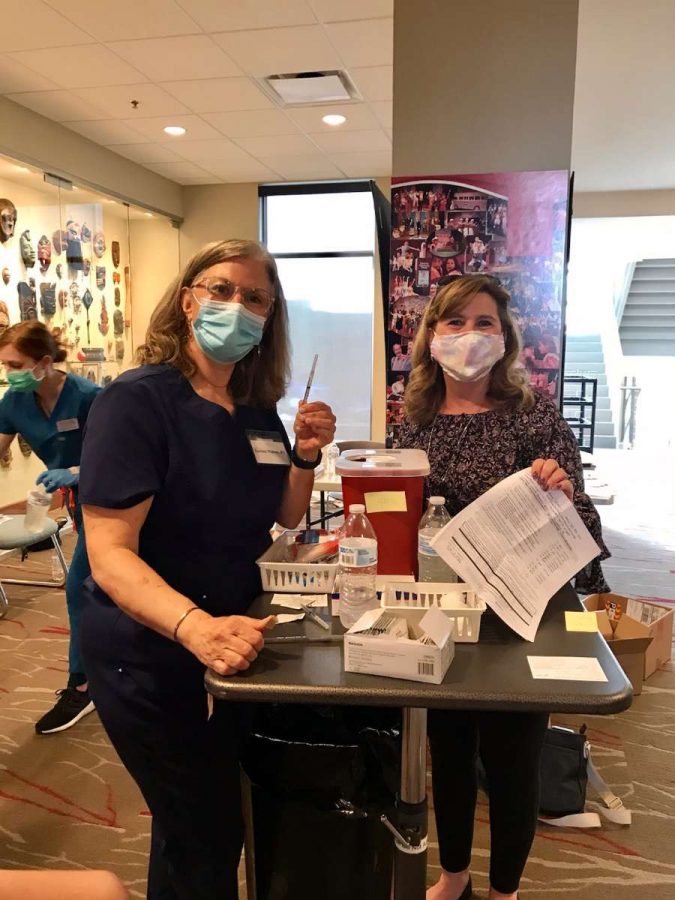Bishop Vaccinebury
April 9, 2021
Last March, Seabury’s extended spring break turned into online classes for the rest of the year, and life as we knew it came to a standstill. Now, over a year later, the landscape is beginning to change.
Kansas is now in Stage 5 of its vaccine rollout, a process that began not long after Pfizer and Moderna both announced successful vaccine trials in November. This means that everyone aged 16 and up is eligible to sign up for the vaccine.
In February, Seabury Senior Audrey Nguyen-Hoang visited the Lawrence Memorial Hospital to talk to the people involved in the vaccine distribution.
Initially, there were some hiccups in the rollout: “Any big effort like this requires a lot of preorganization, and I think that was the problem,” says Laura Bennetts, a physical therapist and clinical rehabilitation manager at Lawrence Memorial Hospital. “We had some confusion about ‘is the federal government going to do it or is the state government doing it?’ and it really requires everyone working together to pull something like that off.” Despite some initial disorganization, inoculations have ramped up, and now nearly 33 percent of all Kansans have received at least one vaccine dose. Douglas County has done particularly well, in fact, and Governor Laura Kelly even praised the county over Twitter for putting 4,092 shots into arms last week.
Some people are still hesitant to get the vaccine, however. “I would say that the studies and the research is there to show how effective the vaccines are, but I do understand the hestitiation,” says Madison Urban, a KU Pharmacy student helping at the clinic. “The vaccines came out really quickly. I am definitely pro-vaccine and would advocate for the vaccine anyday, but I would never force anyone to get a vaccine that absolutely didn’t want one.” It is true that the vaccines were developed and approved at record pace, but this does not mean that they were rushed. Between the best medical technology in human history and the emergency removal of bureaucratic red tape, the vaccines were able to be crafted and tested very quickly–and in a time of great need. The only legitimate concerns about the current vaccines pertain to allergic reactions, which some people may have after receiving a dose. “It’s very rare where I see an anaphylactic that lands someone in the hospital in the ER,” says Urban. However, just to be on the safe side, each vaccine clinic has medical personnel at the ready, and after receiving their dose, participants are required to wait for 20 minutes outside and monitor for any reactions that might present themselves.
The clinics require many volunteers–about 200–as well as around 75 staff members from the health department. People from all over have been pitching in, including Seabury’s own Leslie McCaffrey. She has volunteered multiple different times at the Douglas County Fairgrounds clinic and done three different tasks: first, she helped a nurse who was administering the vaccine, by helping check people in (do not worry, McCaffrey is not handling any of the actual injections); the next time, she worked outside to check people in; and the last time, she directed traffic with a distinct McCaffrey flare.
The atmosphere at the clinic is generally a happy one, McCaffrey says: “It’s totally fun. Everyone is so excited to be there and they feel so relieved. It’s probably the best thing I’ve done during the pandemic.” Also, because the clinic McCaffrey worked at was a drive-through one, people often brought companions: “The thing I found so interesting every time I volunteered was how many people bring their dogs. It’s amazing,” she says. “I’d say one out of five cars has a dog.”
McCaffrey is also impressed with how the Douglas County Health Department has handled the rollout. “They’ve done such a good job figuring out the logistics,” she says. “It’s amazing to me how many vaccines they get done. On Friday [April 2nd], when I was there, we did over 4,000 vaccines from 10:00 to 3:40.”
The clinics are also a place for those who wish to pursue a career in medicine later on. “They have all the pharmacy students at KU drawing the vaccines and getting them ready right there,” says McCaffrey. “They’re utilizing so many resources in the community to make it happen, and it’s really a nice effort. They’ve done a good job at using every resource they can to make it happen.”
